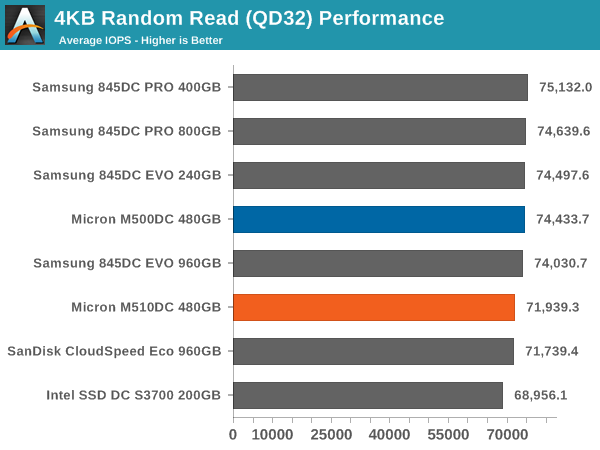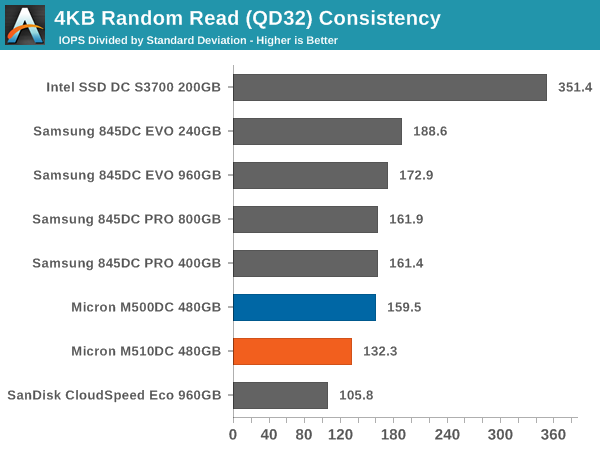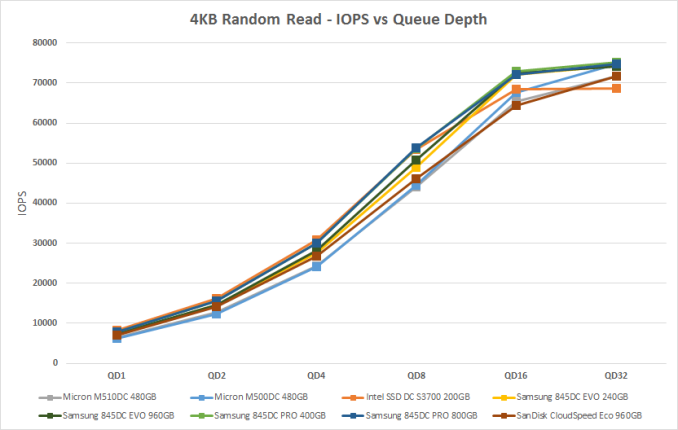Micron M510DC (480GB) Enterprise SATA SSD Review
by Kristian Vättö on July 21, 2015 8:00 AM EST4KB Random Read
With 4KB random writes and mixed workloads out of the way, that leaves us with only pure random reads remaining. The test is a two-hour span and the results correspond to an average of the last 500 seconds of the run.

In random read performance, the difference between SATA drives is negligible. At best the difference is 10%, but between most drives we are looking at less than 5%.
At QD8 and QD16 the difference is a bit larger and not in favor of the M510DC. The EVO does deliver better performance in this case, but not substantially.

There aren't major differences in consistency either and only the S3700 has a notable lead in this area.

The M510DC isn't as power efficient as I would like it to be because it's outperformed by the EVOs again. It's not a significant margin, but with better performance and efficiency the EVO is turning out to be a better drive for read workloads.











22 Comments
View All Comments
Oyster - Tuesday, July 21, 2015 - link
Maybe I missed it, but warranty information?twizzlebizzle22 - Tuesday, July 21, 2015 - link
Would there be warrenty information available for the same reason price wasn't?My question is how longevity is affected from 1-2 DWPD
Rekkx - Wednesday, July 22, 2015 - link
5 year or NAND wear out, whichever comes first.marraco - Tuesday, July 21, 2015 - link
I whish to have also the tests for non enterprise SSDs.These drives are not meant for the mass consumer, but enthusiasts like to try, or at least know how enterprise hardware performs on common PCs.
And is not the same to have "an opinion", even if valid, that actually knowing the experimental data.
Somebody will answer that, obviously, enterprise SSDs have different performance and workload targets, but that is no reason to discard consumer tests.
There is a big difference between actually knowing how they work, and just making an educated guess.
Also, enterprise users need to know how common hardware performs on server environments, because sometimes is cost effective to use common hardware for enterprise.
For example, Google used lots of common hardware on his servers, and that gave him a large advantage over older companies, with larger budgets.
Also, server hardware tends to have large validation and life cycles, and that means that it tends to have obsolete hardware. Sometimes is reasonable to use cheaper hardware, which can fail, but also has lower costs of replacement, or other benefits.
DanNeely - Tuesday, July 21, 2015 - link
Agreed. Also, as prices drop SSDs will be making their way onto client OS VM servers; and those will mostly see amped up versions of client workloads on them.ZeDestructor - Friday, July 24, 2015 - link
You say that, but I recently picked up two 800GB Intel DC S3500 SSDs for use in my desktop, since they were near enough to the 960-1TB consumer drives, but brought me the nice benefit of full power-loss protection, higher performance than the Crucal M500/M550/M600/MX200 (though I doubt i'll ever notice it), and at $300 each, were really not that far from the $275 I've seen the 960GB M500 go down to.nils_ - Friday, July 24, 2015 - link
It's also always interesting to see if the price differential for "DC" hardware is justified or if you're just paying up for the label.otherwise - Tuesday, July 21, 2015 - link
Any idea what those ridicluously large caps on the PCB are for? I would hope for better unexpected power failure recovery -- but didn't see anything in the article touting that as a feature.extide - Tuesday, July 21, 2015 - link
Yes that's what they are for, it mentions it on the first page.Flunk - Tuesday, July 21, 2015 - link
Your conclusion is based on the manufacturer's reported reliability rating, but you never tested it. Who's to say if this drive actually is more durable than it's competition? Or even a cheap consumer drive?I know that testing this would be impractical, but it's difficult to judge hardware based solely on the manufacturer's claims.